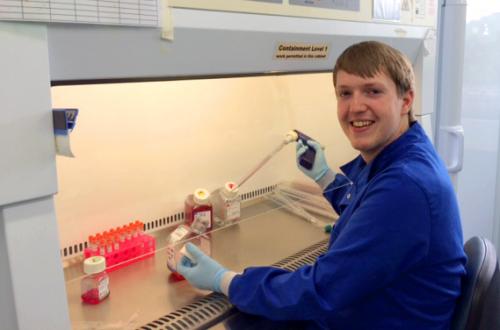
Avoiding cellular indigestion
The lysosome acts as the stomach of the cell in that it digests and recycles unwanted, damaged or toxic cellular components. This is a vital process for the cell and prevents accumulation of 'junk' that can have devastating consequences as is becoming evident in diverse diseases that encompass neurodegeneration and cancer. Material is constantly being delivered to the lysosome by fusion with membrane compartments such as autophagosomes and endosomes, yet in-spite of this, the lysosome retains its identity and does not increase dramatically in size due to all this membrane fusion. Therefore there must be a mechanism whereby membranous material is transported back out of lysosomes. Recent work from the Ganley lab has helped shine light on the signals that allow this process, termed Autophagosome-Lysosome-Reformation (ALR), to proceed.
Michael Munson, during his PhD studies in the Ganley Lab, uncovered that the lipid kinase VPS34 plays a vital part in allowing tubules, which transport out the excess membranes, to break away from the lysosome during ALR. Michael was able to show that not only was VPS34 important, but that it was in turn activated by another kinase, the master growth regulating mTOR protein kinase. This regulation involved direct mTOR phosphorylation of the protein UVRAG, present in a subset of VPS34 protein complexes, and loss of this phosphorylation only seemed to alter ALR. Given that VPS34 is involved in a myriad of other processes, this highlights the specificity that can be achieved in signalling.
The mTOR signalling pathway is often upregulated to drive cell growth in carcinogenesis, so Michael next asked if disruption of ALR, through loss of the UVRAG mTOR phosphorylation sites and concomitant block in lysosomal tubule scission, could alter cell growth. Surprisingly, loss of this phosphorylation resulted in rapid death when cells were stressed by starvation, likely by destabilization of the lysosome and leakage of its destructive hydrolases into the cytosol. Importantly, this suggests that ALR may be a good pathway to target in tumour cells, which are often in a state of starvation caused by their rapid cell growth. Future work will help build on this exciting possibility.
To read a copy of Michael's paper, published in EMBO Journal, click here.
Michael Munson, during his PhD studies in the Ganley Lab, uncovered that the lipid kinase VPS34 plays a vital part in allowing tubules, which transport out the excess membranes, to break away from the lysosome during ALR. Michael was able to show that not only was VPS34 important, but that it was in turn activated by another kinase, the master growth regulating mTOR protein kinase. This regulation involved direct mTOR phosphorylation of the protein UVRAG, present in a subset of VPS34 protein complexes, and loss of this phosphorylation only seemed to alter ALR. Given that VPS34 is involved in a myriad of other processes, this highlights the specificity that can be achieved in signalling.
The mTOR signalling pathway is often upregulated to drive cell growth in carcinogenesis, so Michael next asked if disruption of ALR, through loss of the UVRAG mTOR phosphorylation sites and concomitant block in lysosomal tubule scission, could alter cell growth. Surprisingly, loss of this phosphorylation resulted in rapid death when cells were stressed by starvation, likely by destabilization of the lysosome and leakage of its destructive hydrolases into the cytosol. Importantly, this suggests that ALR may be a good pathway to target in tumour cells, which are often in a state of starvation caused by their rapid cell growth. Future work will help build on this exciting possibility.
To read a copy of Michael's paper, published in EMBO Journal, click here.

